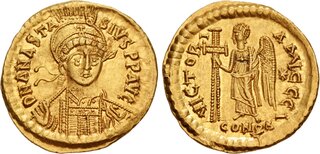| Classical Numismatic Group > Triton XXVII | Auction date: 9 January 2024 |
| Lot number: 939 Price realized: 2,750 USD (Approx. 2,519 EUR) Note: Prices do not include buyer's fees. | Show similar lots on CoinArchives Find similar lots in upcoming auctions on |
| Lot description: Anastasius I. 491-518. AV Solidus (21.5mm, 4.49 g, 6h). Constantinople mint, 10th officina. Struck 492-507. D N ANASTA SIVS PP AVG, helmeted and cuirassed bust facing slightly right, holding spear over shoulder in right hand and shield decorated with horseman motif on left shoulder / VICTORI A AVGGG, Victory standing left, holding long jeweled cross in right hand; star to right; I//CONOB. DOC 3i; MIBE 4a; SB 3. Toned with some luster, trace die rust, a few light scratches, minor deposits. EF. Helmet decorated with the less commonly seen simple cross rather than trefoil. Well struck. A wonderful example struck from charming dies. Lot includes a physical copy of Hess-Leu 36. Ex Dr. Max Blaschegg Collection (Leu Web 22, 20 August 2022), lot 247; Hess-Leu 36 (17 April 1968), lot 602. Upon the death of emperor Zeno, the emperor's widow, Ariadne, was tasked with appointing a successor to the throne. She selected Anastasius, a competent court official and married him, cementing her continued position as empress. Anastasius proved to be an effective ruler for his time, particularly in the area of finances. He completely reformed the coinage and his reforms fundamentally shaped the history of Byzantine coinage which then stood as a model system in stark contrast to the deteriorating situation in the west. Anastasius was also notably Greek Orthodox, a requirement the people requested during the appointment process. Anastasius I is considered to be the first Byzantine ruler on account of both the developments and differences in his rule, and due to the diverging paths of the eastern and western portions of what had long stood as the Roman Empire. This distinction, is of course, largely convenient. The rulers and citizens of the eastern empire, 'Byzantines,' thoroughly considered themselves Romans and referred to themselves as such. It was not until after the fall of the Byzantine state in the mid 15th century AD that western historians began referring to the eastern empire at this time as the 'Byzantine' Empire rather than the continuation of the Roman. In fact, it was even used as a derogatory distinction. However, the fundamental changes that occurred at the time of Anastasius I's reign and continued into the Justinian dynasty as well as the radically different development and practices of the east versus the west lends substantial merit to the delineation that considers Anastasius the first Byzantine ruler. Distinguished as such, Anastasius laid the foundational groundwork essential for a successful civilization that is often overlooked or under-appreciated. The groundwork he laid set the stage for a thriving civilization that endured for a millennium. Estimate: 1000 USD |  |



